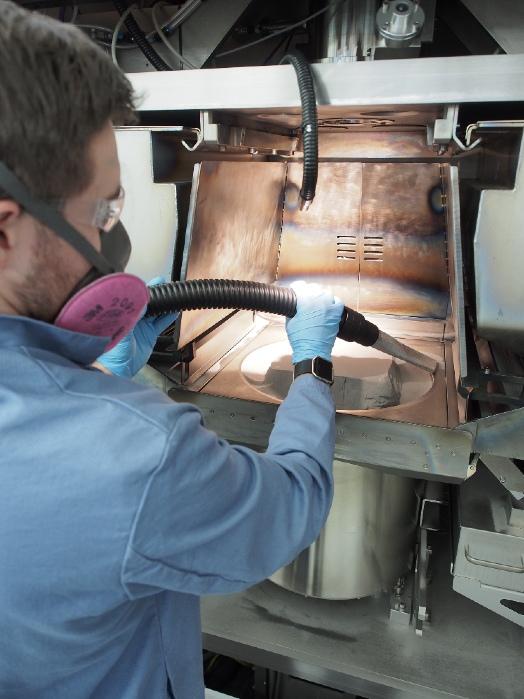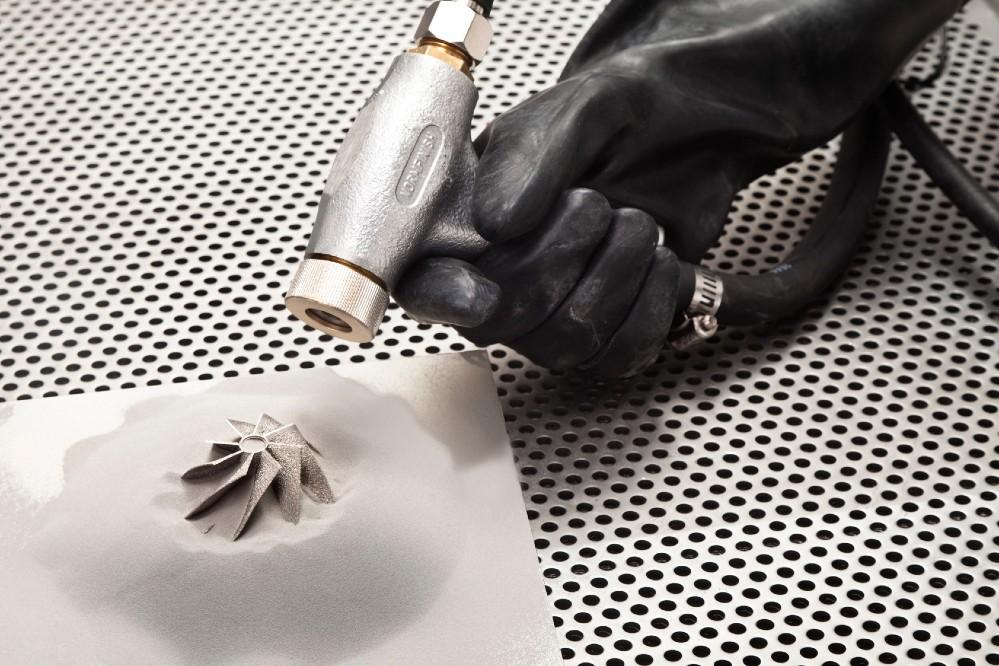- FMA
- The Fabricator
- FABTECH
- Canadian Metalworking
Our Publications
Categories
- Additive Manufacturing
- Aluminum Welding
- Arc Welding
- Assembly and Joining
- Automation and Robotics
- Bending and Forming
- Consumables
- Cutting and Weld Prep
- Electric Vehicles
- En Español
- Finishing
- Hydroforming
- Laser Cutting
- Laser Welding
- Machining
- Manufacturing Software
- Materials Handling
- Metals/Materials
- Oxyfuel Cutting
- Plasma Cutting
- Power Tools
- Punching and Other Holemaking
- Roll Forming
- Safety
- Sawing
- Shearing
- Shop Management
- Testing and Measuring
- Tube and Pipe Fabrication
- Tube and Pipe Production
- Waterjet Cutting
Industry Directory
Webcasts
Podcasts
FAB 40
Advertise
Subscribe
Account Login
Search
Advancements in metal alloys push metal 3D printing forward
Two members of Allegheny Technologies’ additive manufacturing team discuss developments in 3D printing powders
- By William Leventon
- April 19, 2021
- Article
- Additive Manufacturing
For metal additive manufacturing to secure a place among mainstream production options, the materials science area of AM will need to improve. The good news is that companies currently are working to advance materials technology—and they’re seeing positive results.
One such company is Allegheny Technologies Inc. (ATI), a leading player in the metals-making industry. Headquartered in Pittsburgh, it develops specialty materials and also shapes them to meet customer requirements.
ATI sells materials to firms that 3D-print metal parts. It also prints metal parts for customers, a result of its 2018 acquisition of Connecticut-based Addaero Manufacturing, an additive manufacturer of metal components for the aerospace and defense industries.
ATI’s commitment to 3D printing has been in response to customer activity in the field. “We developed our strategy and made investments aligned with supporting our key customer base in aerospace and defense,” said Brian Morrison, ATI’s director of additive manufacturing. “Customers rely on us to provide materials science for additive manufacturing and also as a partner for eventual parts production.” The company’s fully integrated AM supply chain also includes parts finishing.
According to Morrison, 3D printing appeals to ATI’s aerospace and defense clients because it can handle design complexity a couple of ways. One is by facilitating production of complex components that would be difficult, if not impossible, to manufacture using traditional methods. Using AM, “our customers can think outside the box and have the freedom to design parts that perform better,” he said.
Another way is that 3D printing allows the use of complex alloys that can present major problems for conventional manufacturing processes. An example is an alloy ATI produces called titanium aluminide.
“This is very difficult to manufacture in any traditional way, including forging and machining,” Morrison said. “But it’s very useful for additive manufacturing and capable of providing the aerospace-grade parts in production today.”
Alloy Advances
Recent advancements in materials science are producing more and better options for those involved in metal additive manufacturing. Metal AM techniques are essentially microwelding processes, Morrison said, but some traditional alloys are very difficult to weld. So ATI has made small changes to these alloys to improve their weldability.
For example, some high-temperature nickel alloys the company produces have a high alloying content that can cause microcracking in printed parts. This cracking can worsen when the material cools rapidly, generating high residual stresses.
To combat microcracking, ATI made slight changes to the amounts of carbon and other elements in the nickel alloys. These adjustments, combined with corresponding changes to the 3D printing parameters, produce high-performance, low-defect parts, Morrison said.

Specialty-metals developer Allegheny Technologies is focused on improving the powders used in metal 3D printing.
When it comes to metal powders for 3D printing, added Richard Merlino, ATI’s senior director of additive manufacturing and the founder and former president of Addaero Manufacturing, “the next frontier is to go back to the recipe book and look at existing alloys that might not be popular in traditional product forms but could work well for additive manufacturing because they offer properties like good weldability and low residual stress.”
Examples of this are GRCop materials, copper alloys originally developed by NASA. Morrison described the alloys as conductive materials with high temperature resistance used for space-related items such as rocket nozzles and combustion components. Today, he said, GRCop alloys also are being used to print some prototype parts for space applications.
Also high on the priority list is development of new alloys well-suited for AM. Merlino said a titanium alloy the company is working on “shows a lot of promise” when compared to traditional Ti 6-4, the main titanium alloy used in 3D printing.
With laser-based machines, the residual stress that builds up in Ti 6-4 causes deformation during printing, which limits what can be built, he explained. By contrast, the ATI alloy under development offers lower residual stress during the printing process, as well as higher strength and temperature resistance. “That allows you to build complex structures in titanium that you couldn’t build in Ti 6-4,” Merlino said.
In addition, he pointed to the headway being made in the development of aluminum alloys that work well in 3D printing processes and offer better performance than AlSi10Mg, which he called the current “workhorse” aluminum alloy for AM.
He described AlSi10Mg as a low-grade casting alloy that prints well but doesn’t offer much in the way of strength or ductility. As a result, it forces more design compromises than advanced aluminum alloys currently on the market. These offer much better properties than AlSi10Mg but don’t print well, he said. “So people are working on solving that problem and are making progress.”
Material Cost Advantage
In the effort to make metal AM a major production technology, one factor that doesn’t pose a problem is the cost of metal powders, according to Merlino, who still runs the manufacturing facility he founded and ATI acquired.
“Generally, we don’t get a lot of pushback on that,” he said. One reason is that material pricing has come down over the years. In addition, 3D printing makes much better use of materials than conventional manufacturing methods.
“Let’s say you have an extremely complex structure that can be machined,” Merlino said. “You can start out with a 20-lb. block [of material] and end up with a 1-lb. part. This isn’t uncommon, especially in aerospace and defense. So all the savings you may have had by buying the material in traditional product form has gone away as waste.”
Unlike machining, AM consumes almost all the powder purchased for a job, because the process prints a part to near-net shape and any leftover powder is used for subsequent parts. “A very small portion is scrapped in the end,” Morrison said.

Besides producing specialty materials, ATI prints high-end aerospace and defense components. Shown are one of the company’s GE Additive Arcam EBM Q20 AM machines.
High-Volume Hurdles
Like other firms in the field, ATI’s metal 3D printing work tends to be low-volume part runs. A number of things will need to happen for the technology to make the leap into higher-volume manufacturing.
For one, Merlino said, engineers have to get better at designing products for additive manufacturing. Though there are exceptions, “people don’t necessarily know how to design yet to take advantage of the technology,” he said. “That has to come along over time, and it’s going to be driven by kids in universities and training programs.”
In addition, the productivity of metal 3D printing machines must improve. Though Merlino sees technological advancements being made and fabrication times per cubic inch coming down, he said the machines still aren’t fast enough to compete with casting.
As for materials-related advances in metal 3D printing, Morrision said ATI is working on improving powder-atomization processes in order to boost production capacities and lower costs. One goal is to make powders spread better when deposited in very thin layers.
So, will metal 3D printing simply continue as a useful option for low-volume production? Merlino doesn’t think so. He believes the technology will eventually be ready for a new niche: high-volume production of highly complex parts that can’t be realistically manufactured any other way.
For parts like these, “the performance benefits justify building in high volumes with additive,” he said. “And applications like that will be found on a regular basis.”
About the Author

William Leventon
(609) 926-6447
About the Publication
- Podcasting
- Podcast:
- The Fabricator Podcast
- Published:
- 04/16/2024
- Running Time:
- 63:29
In this episode of The Fabricator Podcast, Caleb Chamberlain, co-founder and CEO of OSH Cut, discusses his company’s...
- Trending Articles
- Industry Events
16th Annual Safety Conference
- April 30 - May 1, 2024
- Elgin,
Pipe and Tube Conference
- May 21 - 22, 2024
- Omaha, NE
World-Class Roll Forming Workshop
- June 5 - 6, 2024
- Louisville, KY
Advanced Laser Application Workshop
- June 25 - 27, 2024
- Novi, MI




























